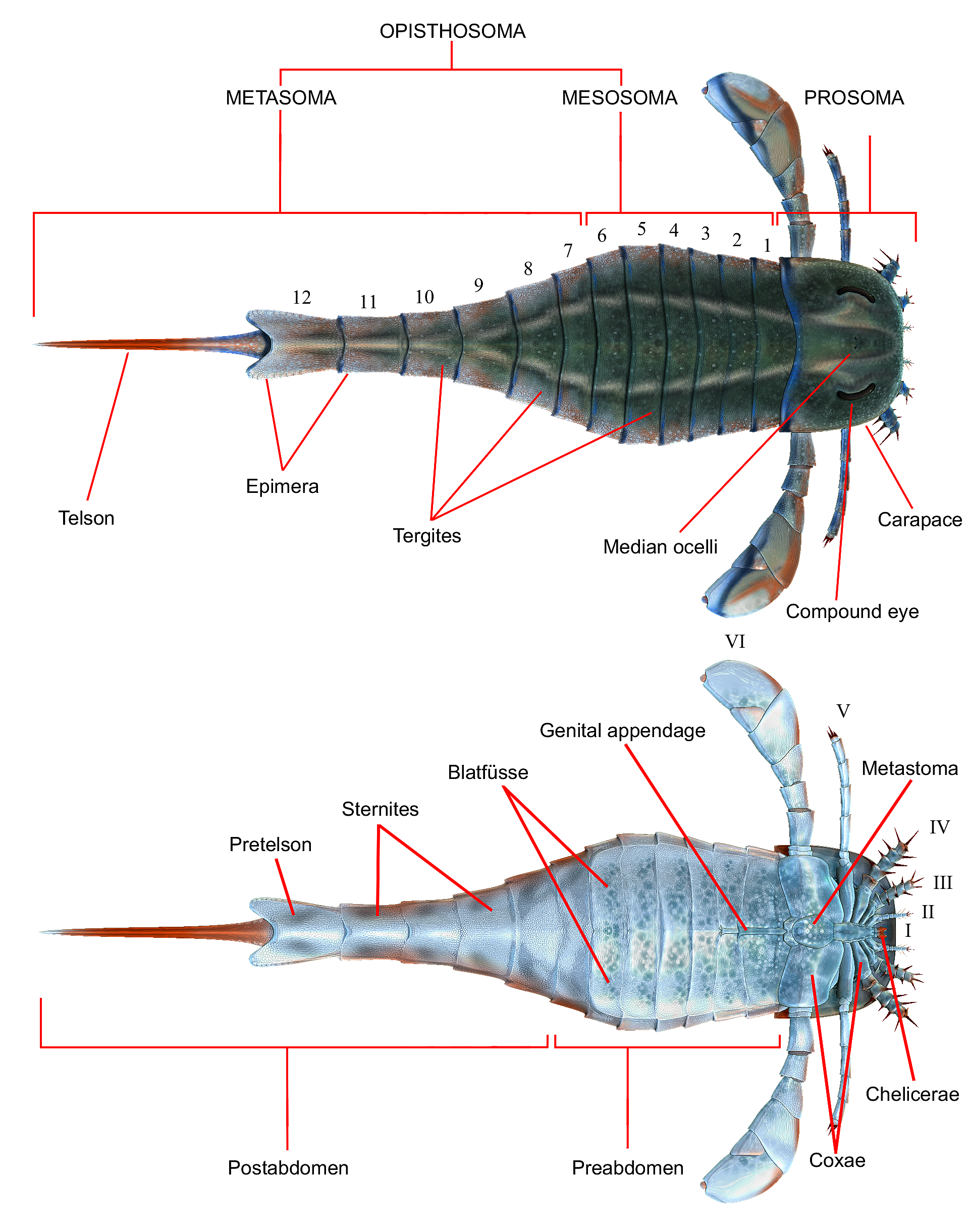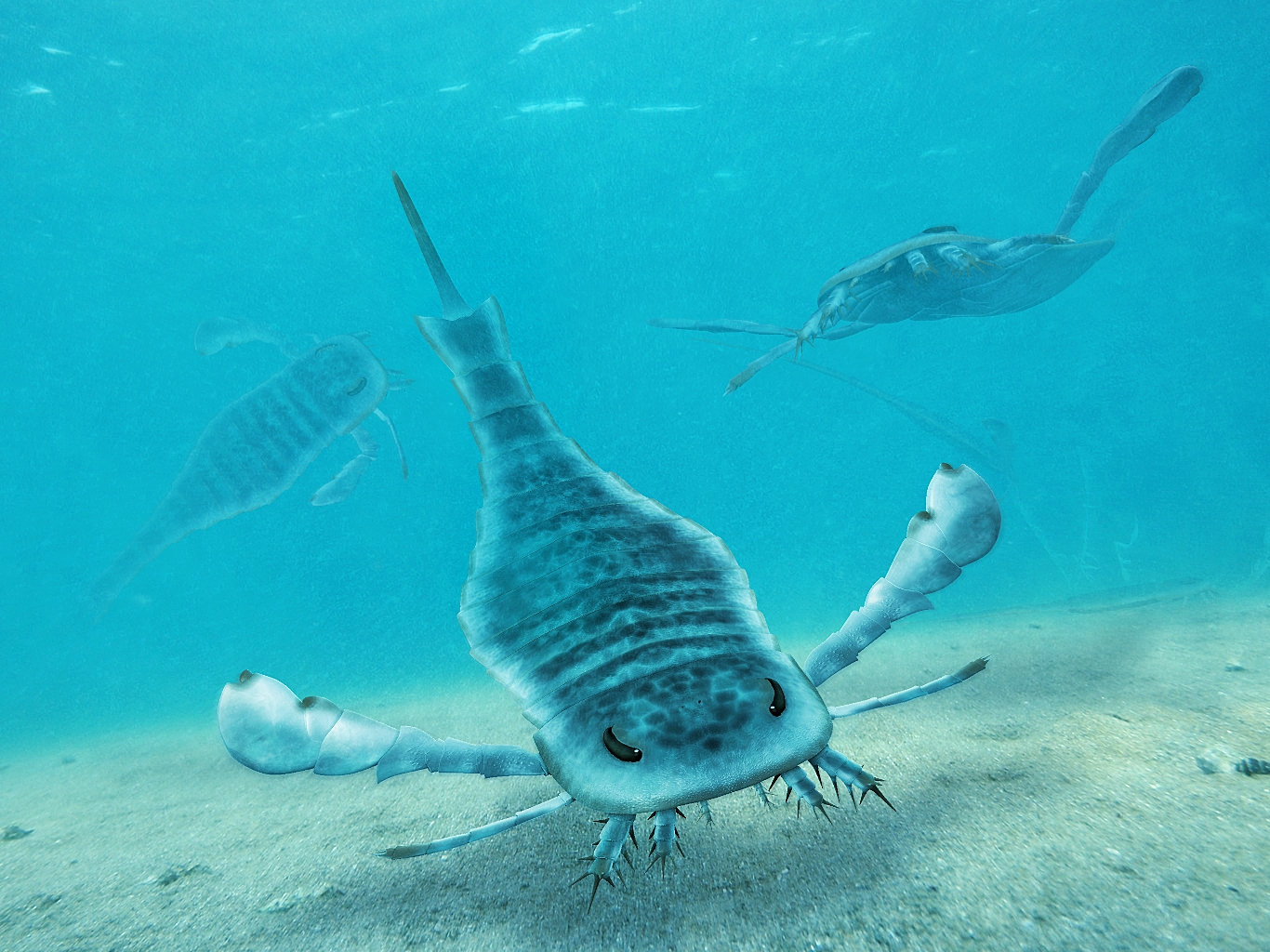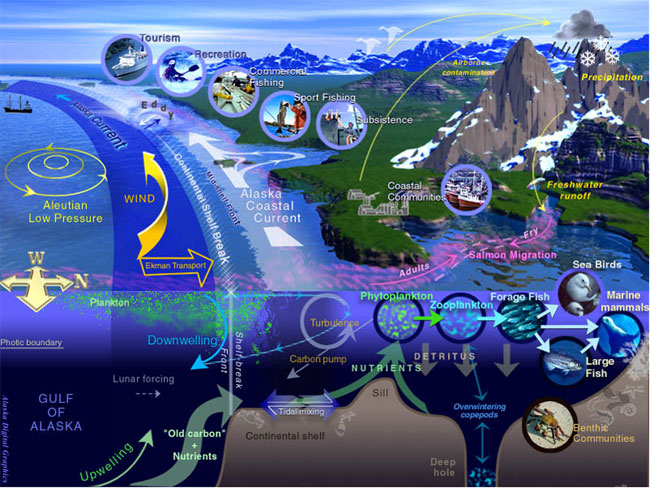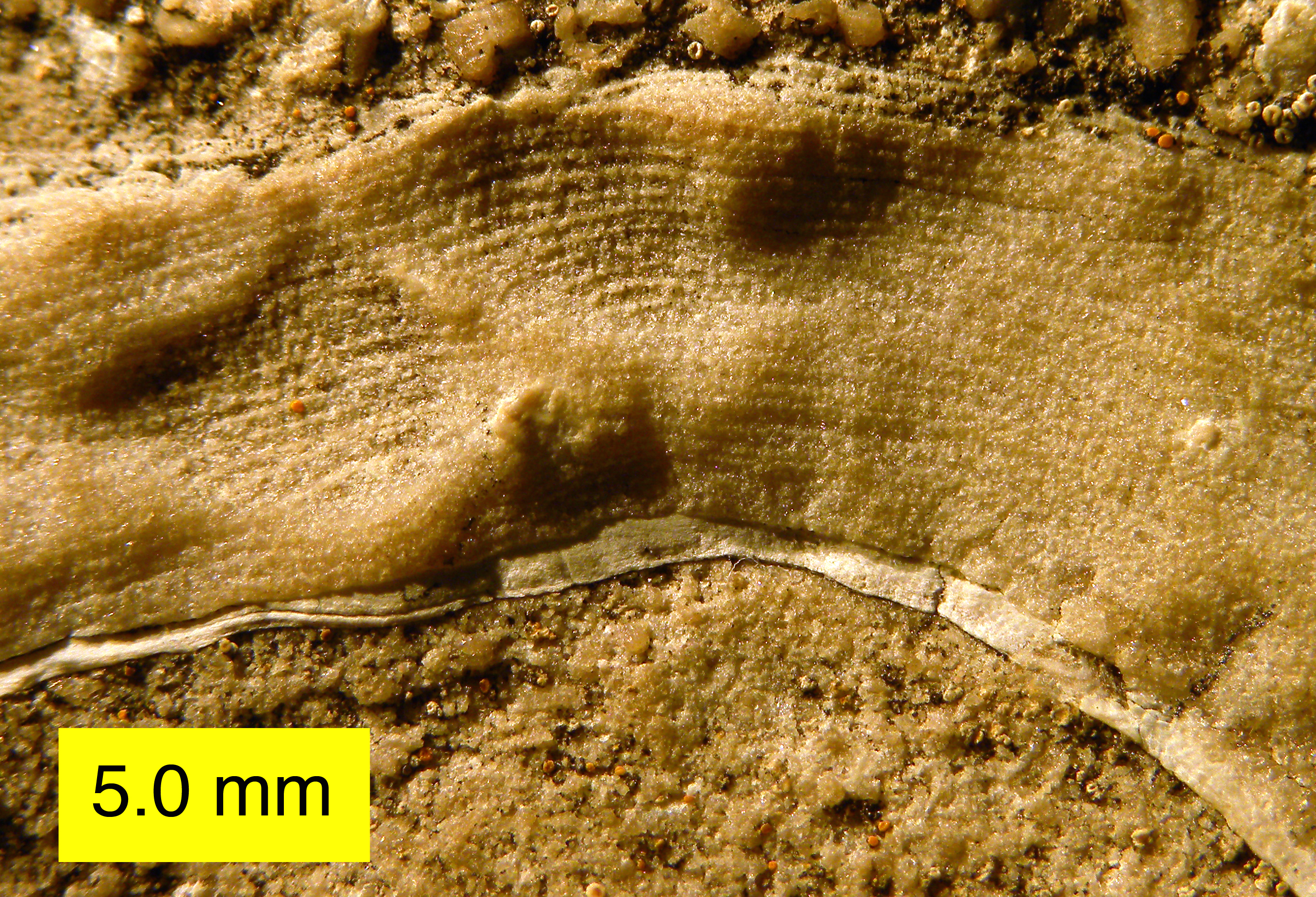|
Eurypterids
Eurypterids, often informally called sea scorpions, are a group of extinct arthropods that form the order Eurypterida. The earliest known eurypterids date to the Darriwilian stage of the Ordovician period 467.3 million years ago. The group is likely to have appeared first either during the Early Ordovician or Late Cambrian period. With approximately 250 species, the Eurypterida is the most diverse Paleozoic chelicerate order. Following their appearance during the Ordovician, eurypterids became major components of marine faunas during the Silurian, from which the majority of eurypterid species have been described. The Silurian genus ''Eurypterus'' accounts for more than 90% of all known eurypterid specimens. Though the group continued to diversify during the subsequent Devonian period, the eurypterids were heavily affected by the Late Devonian extinction event. They declined in numbers and diversity until becoming extinct during the Permian–Triassic extinction event (or sometim ... [...More Info...] [...Related Items...] OR: [Wikipedia] [Google] [Baidu] |
Eurypterus
''Eurypterus'' ( ) is an extinct genus of eurypterid, a group of organisms commonly called "sea scorpions". The genus lived during the Silurian period, from around 432 to 418 million years ago. ''Eurypterus'' is by far the most well-studied and well-known eurypterid. ''Eurypterus'' fossil specimens probably represent more than 95% of all known eurypterid specimens. There are fifteen species belonging to the genus ''Eurypterus'', the most common of which is ''E. remipes'', the first eurypterid fossil discovered and the List of U.S. state fossils, state fossil of New York (state), New York. Members of ''Eurypterus'' averaged at about in length, but the largest individual discovered was estimated to be long. They all possessed spine-bearing appendages and a large paddle they used for swimming. They were Generalist and specialist species, generalist species, equally likely to engage in predation or scavenging. Discovery The first fossil of ''Eurypterus'' was found in 1818 by S ... [...More Info...] [...Related Items...] OR: [Wikipedia] [Google] [Baidu] |
Dorfopterus
''Dorfopterus'' is a genus of eurypterid, a group of extinct aquatic arthropods. Only one fossil of the single and type species, ''D. angusticollis'', has been discovered in deposits of the Early Devonian period (Emsian stage) in the Beartooth Butte Formation in Wyoming, in the United States. The first half of the name of the genus honors the discoverer of this formation, Erling Dorf, while the second half consists in the Ancient Greek word πτερόν (''pteron''), meaning "wing". The species name ''angusticollis'' is composed by the Latin words '' angustus'' ("narrow") and '' collum'' ("neck"). The only known specimen of ''Dorfopterus'' consists of an incomplete uncrushed telson (the posteriormost division of the body), which was long, narrow, styliform and with a central carina ("keel"). It had a special ornamentation consisting of rib-like curved lines on each side of the telson with reticulated (net-like) patterns between them. This ornamentation was unique, and did no ... [...More Info...] [...Related Items...] OR: [Wikipedia] [Google] [Baidu] |
Stylonurina
Stylonurina is one of two suborders of eurypterids, a group of extinct arthropods commonly known as "sea scorpions". Members of the suborder are collectively and informally known as "stylonurine eurypterids" or "stylonurines". They are known from deposits primarily in Europe and North America, but also in Siberia. Compared to the other suborder, Eurypterina, the stylonurines were comparatively rare and retained their posterior prosomal appendages for walking. Despite their rarity, the stylonurines have the longest temporal range of the two suborders. The suborder contains some of the oldest known eurypterids, such as ''Brachyopterus'', from the Middle Ordovician as well as the youngest known eurypterids, from the Late Permian. They remained rare throughout the Ordovician and Silurian, though the radiation of the mycteropoids (a group of large sweep-feeding forms) in the Late Devonian and Carboniferous is the last major radiation of the eurypterids before their extinction in th ... [...More Info...] [...Related Items...] OR: [Wikipedia] [Google] [Baidu] |
Eurypterina
Eurypterina is one of two suborders of eurypterids, an extinct group of chelicerate arthropods commonly known as "sea scorpions". Eurypterine eurypterids are sometimes informally known as "swimming eurypterids". They are known from fossil deposits worldwide, though primarily in North America and Europe. Seventy-five percent of eurypterid species are eurypterines; this represents 99% of specimens. The superfamily Pterygotioidea is the most species-rich clade, with 56 species, followed by the Adelophthalmoidea with 43 species; as sister taxa, they comprise the most derived eurypterines. Pterygotioidea includes the pterygotids, which are the only eurypterids known to have a cosmopolitan distribution. Though more numerous both in specimens and taxa, the eurypterines have the shorter temporal range of the two eurypterid suborders. They first appeared around the same time as the Stylonurina in the Middle Ordovician. The suborder faced a slow extinction during the Middle and Late Devon ... [...More Info...] [...Related Items...] OR: [Wikipedia] [Google] [Baidu] |
Chelicerata
The subphylum Chelicerata (from New Latin, , ) constitutes one of the major subdivisions of the phylum Arthropoda. It contains the sea spiders, horseshoe crabs, and arachnids (including harvestmen, scorpions, spiders, solifuges, ticks, and mites, among many others), as well as a number of extinct lineages, such as the eurypterids (sea scorpions) and chasmataspidids. The Chelicerata originated as marine animals in the Middle Cambrian period; the first confirmed chelicerate fossils, belonging to ''Sanctacaris'', date from 508 million years ago. The surviving marine species include the four species of xiphosurans (horseshoe crabs), and possibly the 1,300 species of pycnogonids (sea spiders), if the latter are indeed chelicerates. On the other hand, there are over 77,000 well-identified species of air-breathing chelicerates, and there may be about 500,000 unidentified species. Like all arthropods, chelicerates have segmented bodies with jointed limbs, all covered i ... [...More Info...] [...Related Items...] OR: [Wikipedia] [Google] [Baidu] |
Marsupipterus
''Marsupipterus'' is a genus of prehistoric eurypterid with an uncertain classification. The genus contains one species, ''M. sculpturatus'', from the Silurian of England.Dunlop, J. A., Penney, D. & Jekel, D. 2015. A summary list of fossil spiders and their relatives. In World Spider Catalog. Natural History Museum Bern, online at http://wsc.nmbe.ch, version 16.0 http://www.wsc.nmbe.ch/resources/fossils/Fossils16.0.pdf (PDF). See also * List of eurypterids This list of eurypterid genera is a comprehensive listing of all genera that have ever been included in the order Eurypterida, excluding purely vernacular terms. The list includes all commonly accepted genera, but also genera that are now conside ... References Eurypterida Silurian eurypterids Fossils of Sweden Eurypterids of Europe {{eurypterid-stub ... [...More Info...] [...Related Items...] OR: [Wikipedia] [Google] [Baidu] |
Scorpion
Scorpions are predatory arachnids of the order Scorpiones. They have eight legs, and are easily recognized by a pair of grasping pincers and a narrow, segmented tail, often carried in a characteristic forward curve over the back and always ending with a stinger. The evolutionary history of scorpions goes back 435 million years. They mainly live in deserts but have adapted to a wide range of environmental conditions, and can be found on all continents except Antarctica. There are over 2,500 described species, with 22 extant (living) families recognized to date. Their taxonomy is being revised to account for 21st-century genomic studies. Scorpions primarily prey on insects and other invertebrates, but some species hunt vertebrates. They use their pincers to restrain and kill prey, or to prevent their own predation. The venomous sting is used for offense and defense. During courtship, the male and female grasp each other's pincers and dance while he tries to move her onto his ... [...More Info...] [...Related Items...] OR: [Wikipedia] [Google] [Baidu] |
Brackish Water
Brackish water, sometimes termed brack water, is water occurring in a natural environment that has more salinity than freshwater, but not as much as seawater. It may result from mixing seawater (salt water) and fresh water together, as in estuaries, or it may occur in brackish fossil aquifers. The word comes from the Middle Dutch root '' brak''. Certain human activities can produce brackish water, in particular civil engineering projects such as dikes and the flooding of coastal marshland to produce brackish water pools for freshwater prawn farming. Brackish water is also the primary waste product of the salinity gradient power process. Because brackish water is hostile to the growth of most terrestrial plant species, without appropriate management it is damaging to the environment (see article on shrimp farms). Technically, brackish water contains between 0.5 and 30 grams of salt per litre—more often expressed as 0.5 to 30 parts per thousand (‰), which is a specific ... [...More Info...] [...Related Items...] OR: [Wikipedia] [Google] [Baidu] |
Marine Life
Marine life, sea life, or ocean life is the plants, animals and other organisms that live in the salt water of seas or oceans, or the brackish water of coastal estuaries. At a fundamental level, marine life affects the nature of the planet. Marine organisms, mostly microorganisms, produce oxygen and sequester carbon. Marine life in part shape and protect shorelines, and some marine organisms even help create new land (e.g. coral building reefs). Most life forms evolved initially in marine habitats. By volume, oceans provide about 90% of the living space on the planet. The earliest vertebrates appeared in the form of fish, which live exclusively in water. Some of these evolved into amphibians, which spend portions of their lives in water and portions on land. One group of amphibians evolved into reptiles and mammals and a few subsets of each returned to the ocean as sea snakes, sea turtles, seals, manatees, and whales. Plant forms such as kelp and other algae grow ... [...More Info...] [...Related Items...] OR: [Wikipedia] [Google] [Baidu] |
Permian–Triassic Extinction Event
The Permian–Triassic (P–T, P–Tr) extinction event, also known as the Latest Permian extinction event, the End-Permian Extinction and colloquially as the Great Dying, formed the boundary between the Permian and Triassic geologic periods, as well as between the Paleozoic and Mesozoic eras, approximately 251.9 million years ago. It is the Earth's most severe known extinction event, with the extinction of 57% of biological families, 83% of genera, 81% of marine species and 70% of terrestrial vertebrate species. It was the largest known mass extinction of insects. There is evidence for one to three distinct pulses, or phases, of extinction. The scientific consensus is that the main cause of extinction was the large amount of carbon dioxide emitted by the volcanic eruptions that created the Siberian Traps, which elevated global temperatures, and in the oceans led to widespread anoxia and acidification. Proposed contributing factors include: the emission of much additi ... [...More Info...] [...Related Items...] OR: [Wikipedia] [Google] [Baidu] |
Late Devonian Extinction Event
The Late Devonian extinction consisted of several extinction events in the Late Devonian Epoch, which collectively represent one of the five largest mass extinction events in the history of life on Earth. The term primarily refers to a major extinction, the Kellwasser event (also known as the Frasnian-Famennian extinction), which occurred around 372 million years ago, at the boundary between the Frasnian stage and the Famennian stage, the last stage in the Devonian Period.Racki, 2005McGhee, George R. Jr, 1996. The Late Devonian Mass Extinction: the Frasnian/Famennian Crisis (Columbia University Press) Overall, 19% of all families and 50% of all genera became extinct. A second mass extinction, the Hangenberg event (also known as the end-Devonian extinction), occurred 359 million years ago, bringing an end to the Famennian and Devonian, as the world transitioned into the Carboniferous Period. Although it is well established that there was a massive loss of biodiversity in the Late ... [...More Info...] [...Related Items...] OR: [Wikipedia] [Google] [Baidu] |









